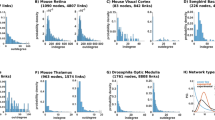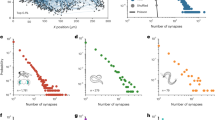Abstract
In this article, we analyse under which conditions an abstract model of connectivity could actually be embedded geometrically in a mammalian brain. To this end, we adopt and extend a method from circuit design called Rent’s Rule to the highly branching structure of cortical connections. Adding on recent approaches, we introduce the concept of a limiting Rent characteristic that captures the geometrical constraints of a cortical substrate on connectivity. We derive this limit for the mammalian neocortex, finding that it is independent of the species qualitatively as well as quantitatively. In consequence, this method can be used as a universal descriptor for the geometrical restrictions of cortical connectivity. We investigate two widely used generic network models: uniform random and localized connectivity, and show how they are constrained by the limiting Rent characteristic. Finally, we discuss consequences of these restrictions on the development of cortex-size models.
Similar content being viewed by others
References
Abeles M (1991) Corticonics. Neural circuits of the cerebral cortex. Cambridge University Press, New York
Bassett D, Bullmore E (2006) Small-world brain networks. Neuroscientist 12(6): 512–523
Bassett D, Greenfield D, Meyer-Lindenberg A, Weinberger D, Moore S, Bullmore E (2010) Efficient physical embedding of topologically complex information processing networks in brains and computer circuits. PLoS Comput Biol 6(4): e1000748
Beiu V, Madappuram B, Kelly P, McDaid L (2009) On two-layer brain-inspired hierarchical topologies—a Rent’s Rule approach. In: LNCS transactions on high-performance embedded architecture and compilers, vol 4(4), pp 1–22
Binzegger T, Douglas R, Martin K (2004) A quantitative map of the circuit of cat primary visual cortex. J Neurosci 24(39): 8441–8453
Braitenberg V (2001) Brain size and number of neurons: an exercise in synthetic neuroanatomy. J Comput Neurosci 10: 71–77
Braitenberg V, Schüz A (1998) cortex: statistics and geometry of neuronal connectivity. Springer, New York
Brunel N (2000) Dynamics of sparsely connected networks of excitatory and inhibitory spiking neurons. J Comput Neurosci 8: 183–208
Changizi M (2007) Scaling the brain and its connections. In: Kaas J (ed) Evolution of nervous systems. Elsevier, Oxford
Chklovskii D (2004) Exact solution for the optimal neuronal layout problem. Neural Comput 16: 2067–2078
Christie P, Stroobandt D (2000) The interpretation and application of Rent’s Rule. IEEE Trans VLSI Syst 8(6): 639–648
Donath W (1979) Placement and average interconnection lengths of computer logic. IEEE Trans Circ Syst 26(4): 272–277
Hagen L, Kahng A, Fadi J, Ramachandran C (1994) On the intrinsic Rent parameter and spectra-based partitioning methodologies. IEEE Trans Comput Aid Des Integr Circ Syst 13: 27–37
Harrison K, Hof P, Wang SH (2002) Scaling laws in the mammalian neocortex: does form provide clues to function. J Neurocytol 31: 289–298
Häusler S, Schuch K, Maass W (2009) Motif distribution, dynamical properties, and computational performance of two data-based cortical microcircuit templates. J Physiol 103: 73–87
Hellwig B (2000) A quantitative analysis of the local connectivity between pyramidal neurons in layers 2/3 of the rat visual cortex. Biol Cybern 82: 111–121
Karypis G, Kumar V (2000) Multilevel k-way hypergraph partitioning. VLSI Des 11(3): 285–300
Kremkow J, Kumar A, Rotter S, Aertsen A (2007) Emergence of population synchrony in a layered network of the cat visual cortex. Neurocomputing 70: 2069–2073
Landman B, Russo R (1971) On a pin versus block relationship for partitions of logic graphs. IEEE Trans Comput C 20(12): 1469–1479
Lanzerotti M, Fiorenza G, Rand R (2004) Interpretation of Rent’s Rule for ultralarge-scale integrated circuit designs, with an application to wirelength distribution models. IEEE Trans VLSI Syst 12(12): 1330–1347
Mehring C, Hehl U, Kubo M, Diesmann M, Aertsen A (2003) Activity dynamics and propagation of synchronous spiking in locally connected random networks. Biol Cybern 88: 395–408
Newman M (2003) The structure and function of complex networks. SIAM Rev 45: 167–256
Pakkenberg B, Gundersen H (1997) Neocortical neuron number in humans: effect of sex and age. J Comput Neurol 384: 312–320
Partzsch J, Schüffny R (2009) On the routing complexity of neural network models—Rent’s Rule revisited. In: ESANN, pp 595–600
Schemmel J, Brüderle D, Grübl A, Hock M, Meier K, Millner S (2010) A wafer-scale neuromorphic hardware system for large-scale neural modeling. In: ISCAS, pp 1947–1950
Schüz A, Chaimow D, Liewald D, Dortenmann M (2006) Quantitative aspects of corticocortical connections: a tracer study in the mouse. Cerebr Cortex 16: 1474–1486
Sporns O, Kötter R (2004) Motifs in brain networks. PLoS Biol 2(11): 1910–1918
Stepanyants A, Chklovskii D (2005) Neurogeometry and potential synaptic connectivity. Trends Neurosci 28(7): 387–394
Stroobandt D, Kurdahi F (1998) On the characterization of multi-point nets in electronic designs. In: 8th Great Lakes symposium on VLSI, pp 344–350
Watts D, Strogatz S (1998) Collective dynamics of small-world networks. Nature 393: 440–442
Young M, Scannell J, Burns G (1995) In: Landes RG (ed) The analysis of cortical connectivity. Springer, New York
Author information
Authors and Affiliations
Corresponding author
Rights and permissions
About this article
Cite this article
Partzsch, J., Schüffny, R. Developing structural constraints on connectivity for biologically embedded neural networks. Biol Cybern 106, 191–200 (2012). https://doi.org/10.1007/s00422-012-0489-3
Received:
Accepted:
Published:
Issue Date:
DOI: https://doi.org/10.1007/s00422-012-0489-3




